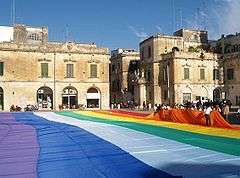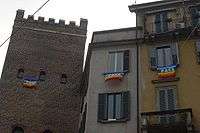Peace flag
There have been several designs for a peace flag.
The Peace Flag initiative
"The Peace Flag" is an initiative that aims to unify all nations underneath one common symbol on International Peace Day. While there are various icons of peace – the olive branch, the dove – there is no official world flag of peace adopted by the United Nations. That’s why this initiative has proposed that, for one day a year on 21 September, every country raises an all-white version of their national flag to represent that we are all one. In 2013, embassies of Colombia, Equatorial Guinea and Ecuador in London officially agreed to support The Peace Flag initiative by raising a colorless version of their respective flags on September 21. The initiative was nominated for a White Pencil in 2012 at D&AD for its contribution towards peace, in support of Peace One Day.
 Colombian Flag of Peace
Colombian Flag of Peace Equatorial Guinean Flag of Peace
Equatorial Guinean Flag of Peace Ecuadorian Flag of Peace
Ecuadorian Flag of Peace
White-bordered national flag

The white flag is recognized in most of the world as a flag of surrender, truce or ceasefire. The first mention of a white flag used in this context is made during the Eastern Han dynasty (AD 25–220). A white flag was also used by the anti-war movement during the US Civil War in 1861.[1][2]
In 1891, the third Universal Peace Congress in Rome devised a generalized Peace Flag design, which was simply the home nation's flag bordered in white to signify non-violent conflict resolution. This was used (although not officially adopted) by the American Peace Society[3] and the Universal Peace Union.[4] It was designed by Henry Pettit.[5]
The International Council of Women's banner

In the 1890s, expatriate American Cora Slocomb di Brazza Savorgnan, the Countess Di Brazza, invented a universal peace flag with three upright bands: yellow, purple, and white, which became the peace flag of the International Peace Bureau.[5] Originally, there was a complicated symbol on the middle band: "a shield ... surmounted by a man's and a woman's clasped hands, sustained by a pair of dove wings with a white star aloft; on the shield can appear any device chosen by the association adopting the flag, or simply the number of enrollment among the users of the flag, or the motto Pro Concordia Labor (For Peace I Work), or this motto may be placed upon a ribbon on the flag beneath the shield, or on a streamer (white) from the flag staff (blue, the color of promise) surmounted by a star with the motto of the association or individual using the flag upon the other white streamer".[6]
This flag was adopted by the International Council of Women in 1896. In 1904, it lost the complicated design and became a simple tricolor.[7]
The Earth flag

James William van Kirk, a Methodist minister from Youngstown (Ohio, USA), designed the first world peace flag of the Earth, using rainbow stripes, stars and a globe. In 1913 and 1929, he made a peace tour through Europe with his flag.[8] He traveled around the world arguing for "the brotherhood of man and the Fatherhood of God".[9]
The Universal Peace Congress eventually came to adopt Kirk's flag as its official World Peace Flag, and it was subsequently adopted by the American Peace Society as well as other groups. It consisted of "the earth on a blue field covered with white stars; a white band crossed the globe and to the left was broken up into a spectrum representing the variations of the human race — different, but united in peace".[5]
In 1938, Kirk authored an autobiography, Stranger than fiction : four times around the world, designer of world flag, a world builder, at 80 years makes a new start in life.
The Banner of Peace

The banner of peace is a symbol of the Roerich Pact. This pact was the first international treaty dedicated to the protection of artistic and scientific institutions and historical monuments.[10] It was signed on April 15, 1935. The banner of peace was proposed by Nicholas Roerich for an international pact for the protection of culture values.
The Rainbow flag
The most common recent design is a rainbow flag representing peace, first used in Italy at a peace march in 1961. The flag was inspired by similar multi-coloured flags used in demonstrations against nuclear weapons. A previous version had featured a dove drawn by Pablo Picasso.[11]
The most common variety has seven colours — purple, blue, azure, green, yellow, orange, and red — and is emblazoned in bold with the Italian word PACE, meaning "peace".
It became popular with the Pace da tutti i balconi ("peace from every balcony") campaign in 2002, started as a protest against the impending war in the world. The flag was flown from balconies in all Italian cities by citizens against the war. Its use spread to other countries too, and the Italian Pace was sometimes, but not everywhere, replaced with the corresponding translation in the local languages.
According to Amnesty International, producer Franco Belsito had produced about 1,000 flags per year for 18 years, and suddenly had to cope with a demand in the range of the millions.[12]
Common variations include moving the purple stripe down below the azure one, and adding a white stripe on top.
The seven-color peace flag is not to be confused with the similar six-color gay pride flag, which does not have azure (it has turquoise) and the colors are in opposite order: with red at the top.
Robert A. Heinlein, in his 1947 short story The Green Hills of Earth, referred to "the rainbow flag of Earth".
The largest peace flag

The first large peace flag was made in Lecce, Salento, Italy by the association "GPace - Youth for peace" on Saturday, 14 November 2009. It was 21 m wide and 40 m long. Three years later this record was broken. On September the 21st 2012 the Belgian Peace Organisation Vrede vzw, Vredeshuis Ghent and five city schools unfolded the worlds largest peace flag (30 m wide and 50 m long) in the historic center of Ghent. The action aimed to reinforce the demand to disarm in order to make room for sustainable development.
Gallery
 United States flag with peace sign canton
United States flag with peace sign canton Greek language rainbow peace flag
Greek language rainbow peace flag
See also
References
- ↑ "The American Annual Cyclopedia and Register of Important Events of the Year". 30 April 1864 – via Google Books.
- ↑ Barnum, Phineas Taylor (30 April 1889). "Struggles and Triumphs: Or, Sixty Years' Recollections of P.T. Barnum, Including His Golden Rules for Money-making". Courier Company – via Google Books.
- ↑ "Peace+Flag" US advocate of peace
- ↑ "The Advocate of Peace". American Peace Society. 30 April 1894 – via Google Books.
- 1 2 3 Devere Allen, ed., The Fight for Peace (New York: Macmillan, 1930), 553, .
- ↑ States, National Council of Women of the United (30 April 1898). "History and Minutes of the National Council of Women of the United States, Organized in Washington, D.C., March 31, 1888". E.B. Stillings – via Google Books.
- ↑ "School Arts". Davis Publications. 30 April 2018 – via Google Books.
- ↑ Corien Glaudemans, 'Een vredesapostel uit Ohio', in: Den Haag Centraal, 16 oktober 2009; for pictures of James William van Kirk and his peace flag, see Haagse Beeldbank; photocollection of the Municipal Archive of The Hague (the Netherlands) nrs. 1.02811 and 5.12996.
- ↑ "How One Minister Paid His Way Round The World". The Western Christian Advocate. C. Holliday and J.F. Wright, 1906.
- ↑ Roerich Pact: Treaty on the Protection of Artistic and Scientific Institutions and Historic Monuments
- ↑ A.E. "La vera storia della bandiera della pace - Notizie storiche sulla bandiera della Pace, la bandiera Arcobaleno della Pace". www.elettrosmog.com.
- ↑ 'Det nytter!', Amnesty International Norway
External links
| Wikimedia Commons has media related to Peace flags. |
